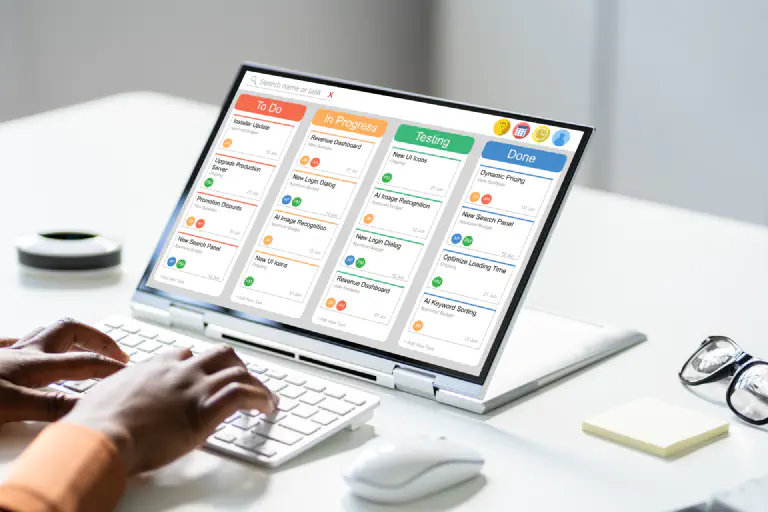Kanban - an agile workflow management method #
Kanban is a very popular agile method to visualize and optimize work processes. With a Kanban board, you can make your team’s work transparent, easily identify bottlenecks and set priorities. The entry barrier is very low and you can integrate this method into your processes without any special preparation or restructuring. However, to really get the most out of it, we recommend that you also familiarize yourself with the Kanban principles .

What should you look out for when choosing the right Kanban tool? #
Kanban is a method that is easy to implement and does not require any special technical setups. Nevertheless, you should not make a hasty decision for or against a digital Kanban board. Available additional functions, the price, user-friendliness and flexibility are important factors that will ultimately have an impact on your satisfaction and the acceptance of the new software in the team. This is because some Kanban board tools differ significantly from one another. We recommend considering these criteria in particular to ensure that the tool is ultimately optimally suited to the requirements of your team and project.
- Task management functions: Can you define subtasks, create checklists, set deadlines and alerts and assign tasks (automatically) to employees?
- WIP limits: Work in Progress limits are an important element in actively preventing your available resources from being overloaded. Can you define and control limits in the tool?
- Real-time collaboration: Can you actually see the current status of tasks, or only with a time delay? Does the tool offer integrated chat and notification functions for a quick exchange?
- Integrations: Can existing tools such as calendars, email or messenger services be seamlessly integrated?
- Reporting: Can you evaluate your processes, record important metrics and create reporting dashboards?
- Price and scalability: How far can you get with Kanban Board freeware and can you scale without needing a new tool?
- User-friendliness: Does your team need onboarding or is the tool intuitive to use?
- Security and data protection: Does the tool offer access restrictions and two-factor authentication? Is it data protection compliant or could you run into data protection issues?

15 Kanban board freeware solutions in comparison #
SeaTable #
The no-code platform SeaTable is a database-based cloud solution for numerous use cases. Users appreciate the flexibility in the implementation of individual customizations as well as the user-friendly interface. SeaTable combines database functions with the simplicity of a spreadsheet and already offers numerous functions in the free plan: various views such as timeline, calendar and Kanban; third-party integrations; notifications and deadline alerts, chat functions; dashboards and a universal app builder. Teams collaborate with each other in real time. Kanban boards can be created with just a few clicks and tasks can be moved simply by drag-and-drop. Automations are included from the Plus plan onwards, WIP limits can be set up via the integrated scripts. Teams can use the Free plan with up to 25 users, there is no limit for Kanban boards. SeaTable stores all data only on servers in Germany and also scores highly in terms of data protection and data security. A special feature: SeaTable also offers an on-premises solution.
Advantages: Intuitive use, real-time collaboration, highly flexible, scalable, can be used as a cloud or on-premises solution, flexible WIP limits via scripts
Disadvantages: Automations only from Enterprise plan upwards
Price: Extensive basic version free of charge for up to 25 users; then from €7 per user/month
ClickUp #
ClickUp is a popular project and communication management tool. The Kanban boards in ClickUp are customizable and allow you to create individually adaptable workflows. Integrated automation rules, chat functions, deadline warnings and user-defined fields for status control as well as the possibility to set WIP limits round off this Kanban tool freeware. The high complexity, which makes it difficult for beginners in particular to get started quickly, and recurring performance problems must be rated negatively. ClickUp stores all data on servers in the USA and is therefore not convincing in terms of data protection.
Advantages: Flexible, integrated dashboards, comment function, tool integrations
Disadvantages: Steep learning curve for beginners, occasional performance problems, compromises in data protection
Price: Free with limited functions for max. 5 projects; extended plans from €6.68 per user/month
Trello #
Trello is a well-known and simple tool that is used in particular by small teams and individuals. The intuitive card and board interfaces allow users to get started quickly. However, the Kanban functions are unsatisfactory overall, in particular the lack of WIP limits restricts functionality. Added to this are the overall limited basic functions and the limit of 10 boards in the free plan. Further functions, such as automation or analyses, are subject to a charge. Trello also stores all data in the USA.
Advantages: User-friendly, quick to learn
Disadvantages: Limited scalability for complex workflows, limited to 10 boards in the free plan, lack of WIP limits
Price: Free in the basic version; premium options from €5 per user/month
Monday.com #
Monday.com is also a project management tool that is particularly known for its list view. Tasks can also be automated here. However, if you are looking for a Kanban solution, this is probably not the right tool for you. Mondays Kanban functions are limited and are restricted to the fact that you can create a board. You can neither create reports nor set WIP limits. As Kanban board freeware, this solution is not at all convincing with its limitation to two users for free use.
Advantages: Intuitive use, automation, flexible views
Disadvantages: Higher costs, complex with complicated processes, no real Kanban functions
Price: Free for 2 users; otherwise from €16 per user/month
MeisterTask #
MeisterTask is a flexible workflow management tool from Austria that focuses on simplifying complex workflows through automation and real-time collaboration. Thanks to its user-friendly interface and intuitive usability you will quickly be able to create your first board. MeisterTask offers automation and can be flexibly customized. However, third-party integrations and reporting are only available to a limited extent in the Free plan. The Free plan is limited to 3 projects and is therefore only suitable for occasional use.
Advantages: flexible and scalable, automation, real-time collaboration
Disadvantages: WIP limits only in the Pro version, limited integrations and reporting functions in the Free plan
Price: Free to use for 3 projects, thereafter €13.50 per user/month
Kanban Tool #
The Polish software Kanban-Tool is one of the older free Kanban tools and impresses above all with its ease of use. A big plus point is the time monitoring function, with which you can record important metrics such as lead time. In terms of real-time collaboration, however, the tool can only be recommended to a limited extent,** especially larger teams will quickly reach their limits here.
Advantages: Easy to use, time monitoring, real-time updates, WIP limits
Disadvantages: Limited use for larger teams, outdated user interface, limited integrations, automation only from Enterprise
Price: Free for two users and two boards, team plan from €6 per user/month
Asana #
Asana is one of the best-known workflow management tools on the market and offers other visualization functions in addition to Kanban. The ability to divide tasks into manageable subtasks is particularly practical. The tool offers integrated automation rules and notification functions, but only limited analysis and reporting functions, so you cannot record any performance metrics. You also cannot set WIP limits.
Advantages: multiple integrations, good collaboration tool, automations, notifications
Disadvantages: Limited reports and automations in the free version, no WIP limits
Price: Free for up to 10 users; extended plans from €10.99 per user/month
Jira #
Jira is the standard tool for software developers to map agile task and project management . You can create Kanban columns with WIP limits. However, performance metrics can only be recorded with paid add-ons. Overall, Jira offers a convincing overall functional package. However, due to its complexity and elaborate configuration, it can quickly become overwhelming, especially for users outside of IT. One plus point is the optional data residency from the Plus version onwards.
Advantages: Agile methods, versatile integrations, detailed error tracking
Disadvantages: Complex setup, challenging for non-technical users, paid add-ons for performance analysis
Price: Free up to 10 users without data residency; Plus version from around €6.50 per user/month
Zoho Projects #
The Indian software Zoho Projects combines task and time management with chat and comment functions. The tool is well suited for decentralized teams, but comes with limitations as a digital Kanban board. The tool offers real-time collaboration, a flexible column view and the option of assigning subtasks to a task. However, WIP limits are missing completely, while alerts and notifications cannot be used in the free version. The limit of two projects in the free version means that even small teams quickly reach their limits.
Advantages: Real-time communication, subtasks, flexibly customizable
Disadvantages: limited tool integration in the free plan, no WIP limits, somewhat more complex user interface
Price: Free up to 3 users and 2 projects; Plus from €4 per user/month
Microsoft Planner #
If you already use the Microsoft Suite or Microsoft Teams, then Microsoft Planner is a good choice as Kanban Board freeware. Compared to other tools, however, Microsoft’s solution is not convincing, as apart from basic functions such as real-time collaboration, task assignment and notifications, it lacks advanced functions, e.g. WIP limits or flexible dashboards. Overall, Microsoft Planner can only be customized to a limited extent.
Advantages: Seamless Microsoft integration, easy to use
Disadvantages: Limited customization, limited Kanban functions
Price: Free for Microsoft 365 users, otherwise from €8.60 per user/month
Businessmap #
Businessmap (formerly Kanbanize) is a Bulgarian software solution that is particularly suitable for visualizing complex processes. In addition to real-time collaboration, automation and WIP limits, Businessmap offers the option of creating extended process maps alongside Kanban boards. One disadvantage, however, is the complexity of the tool, which makes it difficult for new users to get started. As Kanban Board freeware, Businessmap is only suitable for small projects or to try out Kanban once, as there is only a fourteen-day trial version available
Advantages: Process cards next to Kanban, integrated chat function, WIP limits, automations
Disadvantages: very expensive, steep learning curve
Price: 14-day trial version, then from € 161 for at least 15 users/month
Airtable #
Like SeaTable, Airtable combines spreadsheet and database functions. Users can organize their data in a Kanban view and move tasks using drag-and-drop. The basic functionalities do not differ significantly from SeaTable. However, the option to combine Kanban with timelines is missing, as this view is not included in the free version of AirTable. As an American company with a server location in the USA, this solution is also not fully convincing in terms of data protection law. AirTable does not offer integrated WIP limits, but users can control limits or use scripts via automations. Unlike SeaTable, however, Python scripts, for example, are not integrated.
Advantages: Linking of data records, automation, basic Kanban functions
Disadvantages: No WIP limit, rather expensive, server location in the USA, no timeline view in the free subscription
Price: Free with basic functions for 5 users; otherwise from approx. 17 € per user/month.
KanbanFlow #
KanbanFlow is a simple workflow tool for Kanban boards. A unique selling point is the combination with time recording according to the Pomodoro method. With its strong focus on Kanban, the tool is primarily aimed at beginners who only need basic functions. Although this makes it very easy to get started, this free Kanban tool reaches its limits as soon as requirements increase. Free users have to do without integrations and additional security through two-factor authentication.
Advantages: Good for beginners, integrated Pomodoro timer, prioritization, easy to use
Disadvantages: no integrations in the free plan, no 2FA, limited reporting
Price: Free with limited functions; Premium from around €4.25 per user/month
Wrike #
Wrike offers a combination of Kanban boards, Gantt charts and comprehensive reporting. However, free users have to do without Gantt charts, timelines, dashboards and real-time reporting. The tool only offers a limited chat function, which is a particular problem for larger teams. Although an unlimited number of users can work with the free plan, this does not compensate for the overall limited functions. Anyone looking for simple free Kanban software will find a better overall package with other providers.
Advantages: Simple Kanban boards, WIP limits, integration with numerous third-party tools
Disadvantages: steep learning curve, no advanced Kanban functions or metrics, limited chat function
Price: Free with basic functions; otherwise from around €8.50 per user/month
Which Kanban board freeware is best? #
If you are looking for the right Kanban solution for your company, you are spoiled for choice. Numerous providers offer free tools that differ in terms of their functions, usability and scalability. You should consider the last point in particular when deciding on a Kanban tool freeware. When limited to a few users or a few boards, teams quickly reach a point where they have to switch to a paid plan. If you are looking for the most user-friendly, flexible and scalable solution to create a Kanban board for free, then SeaTable is the clear favorite.
FAQ - Kanban Board Freeware #
What features should a good Kanban board freeware offer?
What restrictions should I expect when using Kanban tool freeware?
Is my data secure when using free Kanban software?
